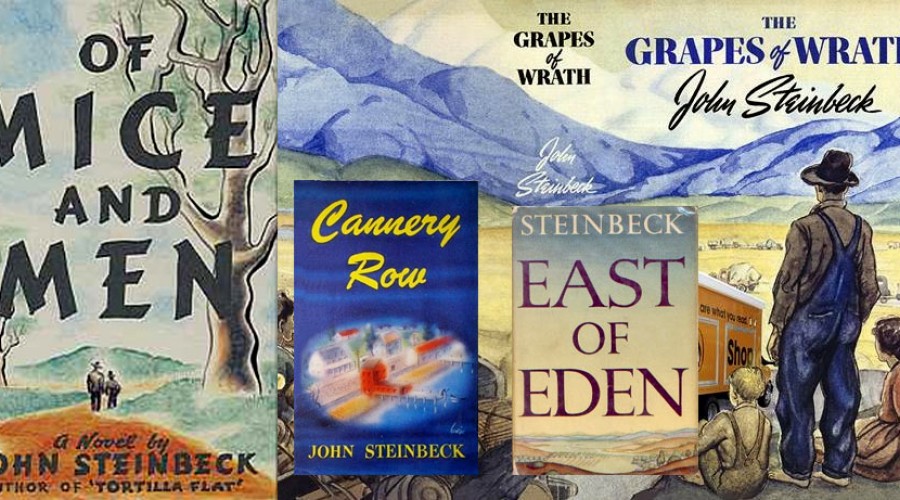John Steinbeck
Printer-friendly John Steinbeck Fact Sheet
John Steinbeck Quick Facts
Born February 27, 1902, 132 Central Avenue, Salinas California, in the front bedroom of the home
Graduated from Salinas High School in June of 1919
Attended Stanford University, 1919-1925
Died of a heart attack in New York, December 20, 1968
Buried in the Garden of Memories Cemetery family plot in Salinas
Steinbeck Family
Father: John Ernst Steinbeck, 1863-1935, Monterey County Treasurer
Mother: Olive Hamilton Steinbeck, 1867-1934, teacher
Sisters:
Esther Steinbeck Rodgers, April 14, 1892-May 9, 1986, lived in Watsonville
Elizabeth Steinbeck Ainsworth: May 25, 1894-October 20, 1992, lived in Pacific Grove
Mary Steinbeck Dekker, January 9, 1905-January 23, 1965, buried in family plot
Wives:
Carol Henning Steinbeck Brown, married1930, divorced from Steinbeck1942, livedinCarmel Valley, died February 8, 1983 at the Community Hospital in Monterey
Gwyndolyn Conger Steinbeck, married 1943, divorced 1948, died December 30, 1975 in Colorado
Elaine Anderson Scott Steinbeck, married 1950, widowed 1968, died 2003, buried in the Garden of Memories in Salinas
Sons:
Thom Steinbeck, born August 2, 1944, author
John Steinbeck IV, June 12, 1946, died February 7, 1991
(mother of Thom and John IV is Gwyndolyn)
Awards and Honors
1935 Commonwealth Club of California Gold Medal for Best Book by a Californian (Tortilla Flat)
1936 The California Novel of 1936 Prize (In Dubious Battle)
1938 New York Drama Critics’ Circle Award (Of Mice and Men)
1939 Member of National Institute of Arts and Letters – American Booksellers’ Award
1940 Pulitzer Prize Fiction Award (The Grapes of Wrath)-New York Times 5-7-1940, 1:2
1946 King Haakon Liberty Cross (The Moon Is Down) 1948 Member of American Academy of Arts and Letters
1962 Nobel Prize for Literature
1963 Honorary Consultant in American Literature to the Library of Congress
1964 United States Medal of Freedom
Trustee of John F. Kennedy Memorial Library Annual Paperback of the Year Award
Press Medal of Freedom
1966 Member of National Arts Council
1979 U.S. Postal Service issued a John Steinbeck Commemorative Stamp 1984 American Arts Gold Medallion of Steinbeck issued by the U.S. Mint
Fiction by John Steinbeck
The Acts of King Arthur and His Noble Knights: From the Winchester MSS of Thomas Malory and Other Sources
1976
Steinbeck’s first posthumously published work. In his reinterpretation of seven tales from Malory completed in 1959 Steinbeck attempts to render Malory “…into a modern English, while…trying to recreate a rhythm and tone…” similar to the original Middle English.
Burning Bright
1950
A play in novelette form presenting the dilemma of a heredity possessed man who discovers he is sterile and must accept another man’s child as his own.
Cannery Row
1945
Steinbeck captures the characters and atmosphere of the row of shacks along the Monterey shoreline now known as Cannery Row.
Cup of Gold: A Life of Henry Morgan, Buccaneer
1929
A tale which traces Henry Morgan’s life from boyhood on the Welsh glens, to his death as lieutenant governor of Jamaica.
East of Eden
1952
The saga of two American families, the Trasks and the Hamiltons, Steinbeck’s own Fiction forebears. The scene is chiefly Salinas from the turn of the century through World War I.
The Grapes of Wrath
1939
Steinbeck’s epic account of the migration of sharecroppers from the Dust Bowl to the mirage of a free and happy life in California.
In Dubious Battle
1936
A labor and strike novel set in the California fruit country, as seen through the eyes of a radical sympathizer.
The Long Valley
1938
Thirteen short stories which portray life in the Salinas Valley.
The Moon is Down
1942
One of Steinbeck’s shorter novels; describes the occupation of a small unnamed mining town by an unidentified army.
Of Mice and Men
1937
The Salinas Valley is the setting for this tale of two drifting ranch hands who dream of a piece of land of their own.
Pastures of Heaven
1932
A series of short stories relating incidents in the lives of a group of people living in a secluded valley in California, Las Pasturas del Cielo.
The Pearl
1947
A retelling of an old Mexican folktale involving the discovery of a great pearl and the ensuing misfortune of the fisherman who found it.
The Red Pony
1933
A heartbreaking true picture of boyhood on a small Salinas Valley ranch.
The Short Reign of Pippin IV
1957
A satirical account of an unsuccessful French attempt at reviving the monarchy with a descendent of Charlemagne.
Sweet Thursday
1954
In this comic, bawdy tale Steinbeck revisits several characters from Cannery Row after World War II.
To a God Unknown
1933
A symbolic and mystical novel of Joseph Wayne and his family and their new land in the fertile hills of California.
Tortilla Flat
1935
Set in a tumble-down-section of Monterey, Steinbeck’s humorous novel portrays the vagabond-type existence and exploits of Danny and his friends.
Uncollected Stories of John Steinbeck
1986
Contains “His Father,” “The Summer Before,” “How Edith McGillcuddy Met R.L. Stevenson,” “Reunion at the quiet Hotel,” “The Miracle of Tepayac,” “The Gifts of Iban,” and “The Time the Wolves Ate the Vice-Principal.”
The Wayward Bus
1947
A “Grand Hotel” type novel in which a group of strangers are stranded overnight at a roadside gas station and lunchroom in California.
The Winter of Our Discontent
1961
Through the life of a New England patrician family, the author portrays some of the shoddy attitudes toward honesty and success. The major theme of the novel is the loss of integrity in our world and the decline in our standards of personal, business, and political morality.
Non-Fiction by John Steinbeck
America and Americans
1966
917.303
Ste
Steinbeck’s text accompanied by photographs renders the many faces of A merica, its scenic beauty as well as its human varieties.
Bombs Away: The Story of a Bomber Team
1942
358.4
Ste
A chronicle of six young men, following their civilian life, through several training schools, and describing how they become airmen.
Forgotten Village
1941
917.2
Ste
An enlightening account which presents the elemental simplicity of daily patterns in a Mexican village.
The Harvest Gypsies
1936
331.54409794
Ste
Reprint of seven newspaper articles about migrant farm workers written by John Steinbeck in 1936.
Journal of a Novel: The East of Eden Letters
1969
813
Ste
A day -‐ by -‐ day account of the writing of East of Eden ; originally a series of letters to Pascal Covici, Steinbeck’s friend and editor at Viking Press.
The Log from the Sea of Cortez
1951
591.92
Ste
A reissue of the narrativ e from The Sea of Cortez to which Steinbeck added a biographical sketch of Ed Ricketts.
Once there Was a War
1958
940.549
Ste
Set in England, Africa, and Italy, this collection of Steinbeck’s World War II news correspondence was written for the New York Herald Tribune in the latter part of 1943.
A Russian Journal
1948
914.7
Ste
An illustrated account of a brief tour of famous Russian cities, the photographs accompanying Steinbeck’s text were taken by Robert Capa.
The Sea of Cortez : A Leisurely Journal of Travel and Research
1941
591.92
Ste
Ed Ricketts and Steinbeck present a scientific account of how marine invertebrates are killed, preserved, and classified. Steinbeck adds an explanation of his philosophy of life.
Steinbeck in Vietnam: Dispatches from the War
959.704
Ste
Dispatches sent to Newsday in 1966 and 1967. T hese columns were the last work published the author during his lifetime.
Travels with Charley: In Search of America
1962
917.3
Ste
Steinbeck’s American voyage of rediscovery accompanied by a distinguished French poodle.
Viva Zapata!
1975
812.52
Ste
Script of the film. It is the story about the part played by Emiliano Zapata in the Mexican Revolution, championing the cause of the peasants during the years 1901 -‐ 1919. It treats themes familiar to readers of The Grapes of Wrath and In Dubious Battle .
Working Days: The Journals of the Grapes of Wrath
1989
818.5203
Ste
Journal kept by Steinbeck during the composition and publication of his classic work , with notes by Robert DeMott.

 Facebook
Facebook Twitter
Twitter Instagram
Instagram Youtube
Youtube